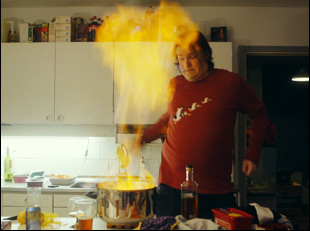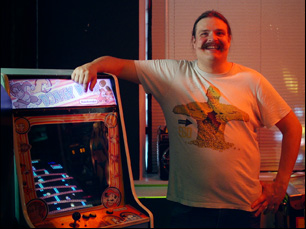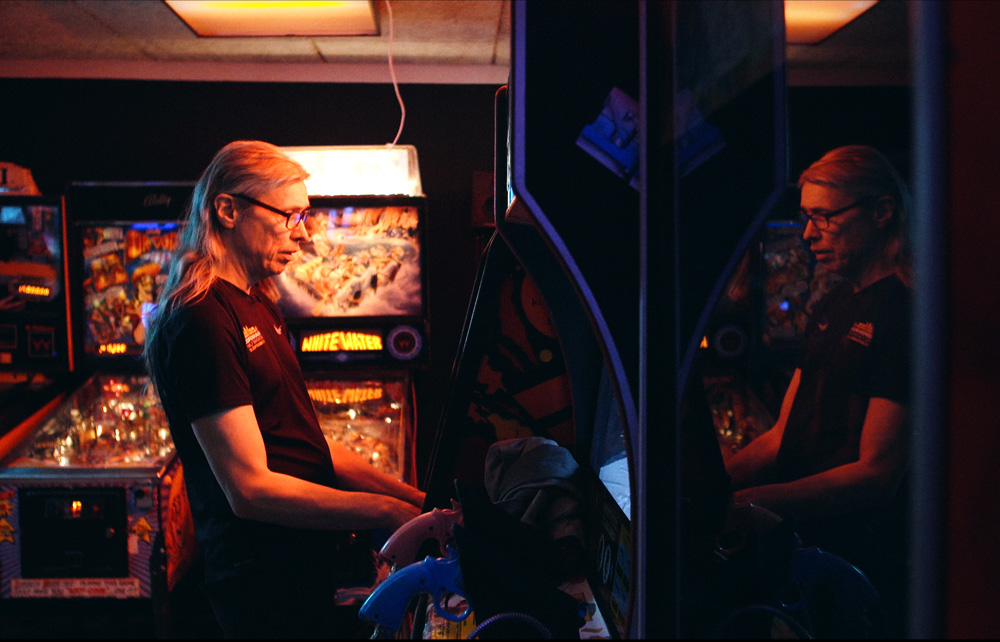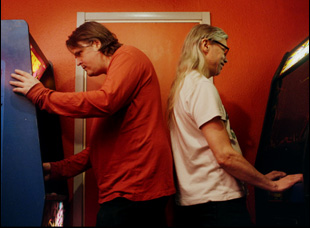Arcade games are often thought of as an individual pursuit, adversarial with another player or a solitary mission pumping quarters into the machine if alone, but to head into the Bip Bip Bar in Copenhagen, one sees the entire galaxy even if it’s home to a true star in Kim Cannon Arm, a legendary player in the region known to run up the score on the space shooter game Gyruss. Realizing that one can parlay three lives into a maximum of 255 that could keep the game going theoretically forever, the soft-spoken Cannon Arm sets his sights on breaking the world record of 59 straight hours on the console and then some with plans to hit 100, but to do so, he’ll not only need perfectly timed bathroom breaks and 15 minutes of shut-eye here and there, but the combined energy of friends Carsten, Dyst and others who spend their nights at the bar rooting him on and grabbing food and drinks for him when he needs the sustenance.
“Cannon Arm and the Arcade Quest” shouldn’t feel as epic as it does when it doesn’t involve Cannon Arm finding his way into an actual spacecraft, instead staring straight ahead at the graphically unsophisticated ’80s game and knowing it so intimately that there’s little reaction to points scored or opportunities missed. However, director Mads Hedegaard makes an extraordinary debut conjuring the magic of what Cannon Arm’s chase for the record has meant for his group of friends, all having very different jobs and interests that they leave at the door of the Bip Bip Bar where they come together as one. Brilliantly, Hedegaard creates a synthesis out of the men’s unique personalities to create a sensory experience on par with the immersion Cannon Arm has when he gets in the zone, offering himself up as a puckish narrator to guide one through a universe where Gyruss opens up considerations of musical theory, the 40-year history of arcade games, poetry and physics, even evolving into a profound mediation on time when a record could mean some small measure of immortality.
With the stimulating flick now screening this week virtually at the Hot Docs Film Festival, Hedegaard spoke about how he quite literally stumbled into such a great subject after accepting an invite to the basement where the Bip Bip Bar was once hidden away, realizing he was making an ensemble piece and creating one of the most clever uses of voiceover this side of Joachim Trier’s “Reprise.”
There was a technician who worked at the film school I was at who was the co-owner of the arcade, so I got to know him and we became friends. He invited me down there and when I walked in the door, it was an explosion of colors and music. It just was a very, very good atmosphere and I started to get to know the people there and it was just like “Oh my God, this is incredible.” It’s just like another world I walked into because I was never really a part of the gaming community in any way. I heard about [Kim Cannon’s] 100-hour record attempt and thought that’s a great story for a film, like if a guy could reach his goal or not, but as I got to know the guys, I just thought, this is incredible. When you meet someone for the first time, it’s just a face and then you start to get to know the person and obviously they reveal themselves and I really wanted to make a point of that in the film. I’m really hoping that the audience might get that feeling like they might look at them in the beginning and they might be a bit funny looking or talk in a certain way and by the end of the film, I hope that they really seem like people that you really want to get to know and hang out with.

Yeah, that was a really big part of me wanting to make the film, or at least having fun making the film because I really started to recognize myself in the different guys. They were so generous and so open and every time they told me a new story, or how they studied physics or how Dyst [wrote] poetry, there were so many moments with each and every one of them that was like, “Wow, this is amazing, let me try to find a way to put that into the film.”
With Dyst and his poetry slam, I used that as an inspiration for writing the voiceover and Carsten’s scientific approach to music and his whole theory about a counterpoint in Bach’s music, I used that as a way of structuring the film, so many of the elements of the film come from the characters. I also really wanted to use the music that they’re listening to in real life – Kim’s favorite band Iron Maiden and some of the other music that’s in the film is music that’s being played in the arcade — so it just made so much sense to have the characters at the outset [dictate] how I decided to structure the film and what elements to use.

That was incredibly complicated, but it was extremely fun as well. In the sound design, we had to almost remove all the natural sounds from the recordings and do all the work to build the whole soundscape again. It does sound a lot like the actual recordings, but since there are so many machines going on at the same time and people talking and partying, we really had to build the whole thing again in order to make the whole thing work, so that was a big job, but extremely funny because we could tweak and just make it right.
Did the idea of doing the voiceover come in fairly early in the process?
In the beginning, I actually thought I was going to do a pure cinema verite film, but then I realized that wasn’t really possible, at least not for me. I couldn’t crack that open partly because Kim is such an introverted character and it’s basically a guy standing in front of a machine for many hours, so I had to find a way to make that entertaining and to get the audience to feel the way he was feeling in a certain way. Like I was talking about really wanting to show the audience these people as people and not only characters in the film, I thought with Kim being a big introvert, I needed an instrument to tell the story about Kim in the right way, and the voiceover was really a revelation. I don’t know where it came from. I had been working with voiceovers before at film school, so it wasn’t completely new, but it seemed completely new and pure. Everything fell into place.

We had a lot of hours to rehearse the different shots and find the right camera positions, so in that sense, we did talk about it beforehand and I had filmed Kim a few times standing at the machine before that, so we had some experience of filming him in that way, but because it was such a long stretch of time, we had time to play around and try out stuff and see is this angle interesting? How about this dolly ride? Does that work? It was very much like playing around with it as it was happening, but also paying a lot attention to how he was feeling. In between when we could film and talk to him, we could try fun stuff and see how it worked.
What’s it like getting to the finish line yourself with it?
It’s amazing. It isn’t that long ago since we finished the film, but for a long time before that, I was really looking forward to showing it to people because I thought it was something special and I really like the film myself. [laughs] So I was really eager to get it out and just see if I was the only one who felt like this, [and the guys] absolutely love it. I don’t think they knew what it could be and after they saw it the first time, they were just blown away. I was really pleased with how they thought that my portrayal of them as individuals, but also as a community was just spot on. That’s really the best reaction I’ve had of any because it was so important to me that they could see themselves in the film and they did.
“Cannon Arm and the Arcade Quest” will stream through Hot Docs, geoblocked to Canada, from April 29th through May 9th.





